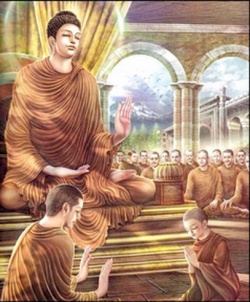Three divisions of the canon
three divisions of the canon
[三蔵] (Skt tripitaka; Pali tipitaka; Jpn san-zo )
Three sections or categories into which the Buddhist teachings are divided.
They are the sutras, or the Buddha's doctrinal teachings;
the vinaya, or rules of monastic discipline;
and the abhidharma, or commentaries on the sutras and the vinaya.
Tri of the Sanskrit tripitaka means three, and pitaka, literally a box or basket, indicates a canonical collection. After Shakyamuni Buddha's death, the Buddha's teachings were compiled at the First Buddhist Council, held under the supervision of Mahakashyapa at the Cave of the Seven Leaves near Rajagriha in Magadha, India. It is said that at that time Ananda recited the sutras and Upali recited the vinaya. The abhidharma section was added later, when various schools began to produce commentaries.
